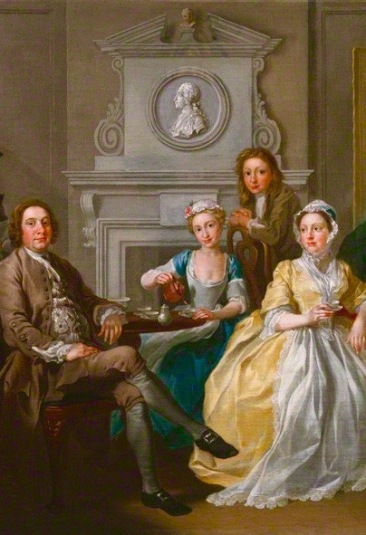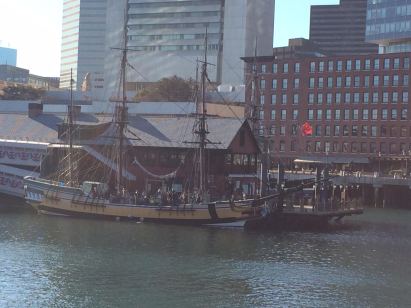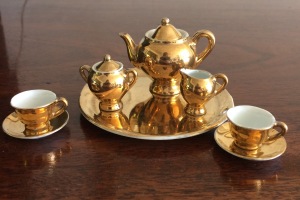In François de La Rochefoucauld’s travel memoir, Mélanges sur l’Angleterre, originally written in 1784, de La Rochefoucauld says that
“The drinking of tea is general throughout England…It gives the rich an opportunity to show off their fine possessions: cups, tea-pots, etc., all made to the most elegant designs, all copies of the Etruscan and the antique. It is also the custom for the youngest daughter or the lady of the house to make the tea.” (The Boydell Press. Translated by Norman Scarfe. 1988)
Here, then, is Susannah, the younger daughter, on 1st January, 1776, writing:

“Mama & Lucy drank tea at Mrs Martin’s. I stayed at home to make tea for Papa and Cousin James”.
MEALTIMES
Susannah’s diary tells us that her family ate Breakfast, Dinner and Supper plus they followed a daily ritual of drinking tea. Susannah never once refers to anything that they ate. At her age and in her social situation, the provision of food was clearly organised by someone else or she might have mentioned it, but it also leads me to think that perhaps their food was repetitive and un-noteworthy. Or might it have been bad manners to mention food? However, Susannah’s constant mention of dinner and tea, and the reliable rhythm created by these, must have leant stability to her daily life.

Breakfast: is mentioned twice as a specific meal first thing in the morning. The contents of breakfast seems to have varied between town and country but would probably have consisted of bread and butter and perhaps jams and marmalade. Eggs and cold meat are another common theme for breakfast.
Dinner: the main meal of the day – was eaten sometime between 3 and 5pm. The meal might consist of 3 courses, the first chiefly meat, the second a combination of meats and puddings, followed by fruit and sweetmeats. In 1781, James Woodforde in his Diary of a Country Parson gave a dinner which, although he lived in the country, may give an idea of what the Dalbiac family ate, consisting of:
“A Couple of Chicken boiled and a Tongue, a Leg of Mutton boiled and Capers and Batter Pudding for the first Course, Second, a couple of Ducks roasted and green Peas, some Artichokes, Tarts and Blancmange. After dinner, Almonds and Raisins, Oranges and Strawberries, Mountain and Port Wines.”
Susannah refers to “Dinner” or where they or someone else “Din’d” 57 times but only once refers to the actual time when on 9th March she noted
 “Papa and Mama came home to dinner at 5 o’clock”
“Papa and Mama came home to dinner at 5 o’clock”
Perhaps this was rather late in the day for dinner and therefore noteworthy.
Tea: came after Dinner : see below
Supper: which was much smaller and eaten later in the evening.
TEA

Susannah mentioned “tea” 77 times in the days between 1st January and 6th July and the drinking of tea was obviously a key moment on every day of the week.
Here is a week when she mentioned tea every day:

Tea at home:
Writing her diary at the age of 14, there is an implied significance to the fact that Susannah has stayed behind specifically to make the tea for her father and cousin.

A certain amount of equipment had to be acquired for the proper taking of tea including a tea table, a tea kettle, a tea caddy, a tea pot, a tea strainer, tea cups, a slops bowl and probably a milk jug and sugar bowl, and I feel sure that Susannah must have enjoyed the responsibility of presiding over the tea table.

By the 1770s they would mostly likely have been drinking black tea (such as Bohea, Congou, Pekoe or Souchong), all imported from China by the British East India Company, who by the 1760s, along with the Dutch East India Company, were importing 720 tonnes into Europe each year. Tea was still an expensive commodity but the diary leaves you in no doubt as to its social and domestic importance for Susannah’s family and friends. Was it the best time of the day for Susannah and Lucy? After the formality of Dinner, was it a chance for them to sit round chatting with their cousins without any obligation to read difficult sermons or do their sewing? I am a great tea drinker and I wonder if they were all a bit dependent on the caffeine too!
Susannah noted either who she or her parents were with and/or where she or her parents were – often different places with different people – but she notes it anyway, thereby giving some emphasis to the occasion each day. For her father, tea time may have been either an important part of his business day or a chance to socialise with friends. He has tea with a whole list of different people and I don’t know how typical this was, but Susannah’s father often appears to socialise with his business partners. He was in business as a “Silk Weaver” with his brother James Dalbiac, referred to by Susannah as “Uncle Dalbiac”, as well as a Mr Barbut and Mr Jourdan, as referenced in Bailey’s Northern Directory, published in 1781, both of whom he takes tea with (and on other occasions even stays the night with).
Out for tea:
On Tuesday 28th May, Susannah wrote:
In the Evening Uncle, Aunt CK, CM, Papa, Mama, Lucy & Me went to see Luxborough House. Drank Tea there.

Luxborough House was the seat of Admiral Sir Edward Hughes and was a local stately home at Chigwell, very close to Wanstead. As in Pride and Prejudice, on Elizabeth Bennett’s Derbyshire tour when she visits Pemberley with her aunt and uncle, visiting stately homes was a popular pastime for the wealthier classes who expected to be allowed to tour the grounds and, if the owner was away, to be shown round the house by the housekeeper. Susannah makes a note of the fact that they “Drank tea there”, perhaps as they were well-to-do local residents, they were invited for more than just a tour of the house that day, or perhaps Admiral Sir Edward was at home, and he and Susannah’s father found a mutual acquaintance in Admiral Sir Francis Geary from Polesden Lacey.
The Boston Tea Party:

I happen to have visited Boston earlier this year and was fascinated to read about the colonialists and some of the history of the colonies in the 18th century. Only 3 years earlier than Susannah’s diary, in 1773, the “Sons of Liberty” in Boston, under cover of darkness and disguised as native americans, got on to three ships in Boston harbour and destroyed and threw overboard 340 chests of tea. The harbour apparently smelt for weeks. An estimate suggests that this was the equivalent of approximately 18,523,000 cups of tea and a loss to the British East India Company of $1,700,000 in today’s money. The colonialists were protesting against taxes imposed by Britain and the destruction of the tea was both a symbolic act and the cause of great financial damage, and was a key instigator of the beginning of the American War of Independence.
Having researched tea-drinking in the mid-late 18th century and got a feeling for both its social and political significance, my conclusion about Susannah’s obsession with tea is, that although I wish Susannah had made even the smallest reference to food, it would have been much more surprising if she had never mentioned the word “tea”.
Susannah and her sister’s tea times are highly sociable: on most days they meet up with their extended family but also often with friends. The Dalbiacs were originally city dwellers but even in their suburban homes in Surrey and Essex, they had friends and family living close by and the daily time for drinking tea allowed them to fulfil their other obligations earlier in the day (which I will look at in a further Post) whilst entertaining themselves, their families and friends, and leading amazingly busy and active lives.



A very strong sense of ‘taking tea’ being an essential ritual – fascinating!
LikeLiked by 1 person
I really enjoyed reading this. All very interesting. Do you have a sense of what time “tea time” would normally have been?
LikeLike
After Dinner so sometime between 5 and 7 o’clock in the evening (I think!)
LikeLike